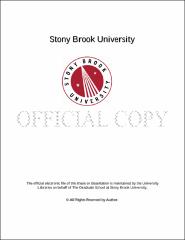| dc.identifier.uri | http://hdl.handle.net/11401/76710 | |
| dc.description.sponsorship | This work is sponsored by the Stony Brook University Graduate School in compliance with the requirements for completion of degree. | en_US |
| dc.format | Monograph | |
| dc.format.medium | Electronic Resource | en_US |
| dc.language.iso | en_US | |
| dc.publisher | The Graduate School, Stony Brook University: Stony Brook, NY. | |
| dc.type | Dissertation | |
| dcterms.abstract | Conformal field theories (CFTs) are of central importance in modern theoretical physics, with applications that range from condensed matter physics to particle theory phenomenology. In this Ph.D. thesis we study CFTs from two somehow orthogonal (but complementary) points of view. In the first approach we concentrate our efforts in two specific examples: the Veneziano limit of N=2 and N=1 superconformal QCD. The addition of supersymmetry makes these theories amenable to analytical analysis. In particular, we use the correspondence between single trace operators and states of a spin chain to study the integrability properties of each theory. Our results indicate that these theories are not completely integrable, but they do contain some subsectors in which integrability might hold. In the second approach, we consider the so-called ``bootstrap program'', which is the ambitious idea that the restrictions imposed by conformal symmetry (crossing symmetry in particular) are so powerful that starting from a few basic assumptions one should be able to fix the form of a theory. In this thesis we apply bootstrap techniques to CFTs in the presence of a boundary. We study two-point functions using analytical and numerical methods. One-loop results were re-obtained from crossing symmetry alone and a variety of numerical bounds for conformal dimensions of operators were obtained. These bounds are quite general and valid for any CFT in the presence of a boundary, in contrast to our first approach where a specific set of theories was studied. A natural continuation of this work is to apply bootstrap techniques to supersymmetric theories. Some preliminary results along these lines are presented. | |
| dcterms.available | 2017-09-20T16:51:01Z | |
| dcterms.contributor | van Nieuwenhuizen, Peter | en_US |
| dcterms.contributor | Rastelli, Leonardo | en_US |
| dcterms.contributor | Dawber, Matthew | en_US |
| dcterms.contributor | Rocek, Martin | en_US |
| dcterms.contributor | Takhtajan, Leon. | en_US |
| dcterms.creator | Liendo, Pedro | |
| dcterms.dateAccepted | 2017-09-20T16:51:01Z | |
| dcterms.dateSubmitted | 2017-09-20T16:51:01Z | |
| dcterms.description | Department of Physics. | en_US |
| dcterms.extent | 159 pg. | en_US |
| dcterms.format | Monograph | |
| dcterms.format | Application/PDF | en_US |
| dcterms.identifier | http://hdl.handle.net/11401/76710 | |
| dcterms.issued | 2013-12-01 | |
| dcterms.language | en_US | |
| dcterms.provenance | Made available in DSpace on 2017-09-20T16:51:01Z (GMT). No. of bitstreams: 1
Liendo_grad.sunysb_0771E_11452.pdf: 927242 bytes, checksum: 6d873b9821b97b9fe4945a17f9543502 (MD5)
Previous issue date: 1 | en |
| dcterms.publisher | The Graduate School, Stony Brook University: Stony Brook, NY. | |
| dcterms.subject | Physics | |
| dcterms.subject | CFT, Supersymmetry | |
| dcterms.title | Uncovering the structure of (super)conformal field theories | |
| dcterms.type | Dissertation | |

